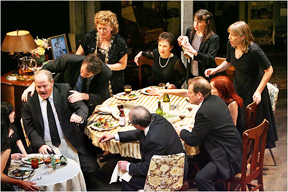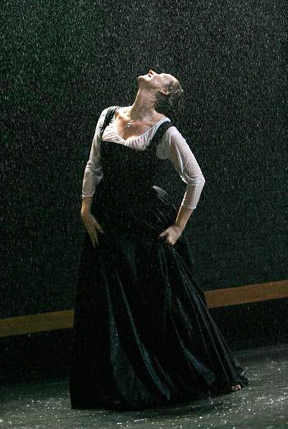Theatre: The Joys of Theatricality
By Wendy Caster
ART TIMES Spring 2016
 Lorenzo Pisoni and Daniel Radcliffe from Equus. (Photo: Carol Rosegg) |
The first show I ever saw was The King and I. It was the umpteenth revival, and I was thrilled by every second. Although it was many years ago, I particularly remember Eleanor Calbes, the actress who played Tuptim.* When she was dragged off stage, threatening suicide, she fought and screamed and cried. I was heartbroken by Tuptim’s anguish and anger. I was blown away by the sheer emotionality of the Calbes’ performance. And I just kept thinking, “Wow, she’s right there in front of me.”
For me, the combination of these responses adds up to a definition of theatricality: intense emotion presented by talented people right in front of you. The dictionary definitions of theatricality come in two parts: (1) related to the theatre; and (2) exaggerated, overdramatic, histrionic. Generally, the second definition is used for behavior outside of a theatre, and that makes sense. There’s a level of emotion and presentation that only works on stage.
Theatricality allows a unique suspension of disbelief. For example, in the play Equus, the horses are played by tall men on metal hooves, wearing metal horse masks that allow us still to see their gorgeous faces. When Alan snaps and attacks them with a steel spike, it’s a shocking and horrifying action that expresses violence, repression, sexuality, nonconformity, and religion. In the movie Equus, the horses are played by horses. And when Alan snaps and attacks them, it’s about a crazy guy blinding a bunch of animals. The horses’ vivid squeals preclude the multiple levels of meaning allowed by the theatricality of the show.
The musical Hamilton (Perhaps you’ve heard of it? It’s been getting a little attention?) is a deeply theatrical piece. The audience is invited to join the celebration of New York, the American Revolution, and the role of immigrants in the success of the US. When the cast sings, “How lucky we are to be alive right now,” they are referring to the late 1700s and to this very second. Hamilton also uses asides to include everyone in the theatre. There’s a delightful throwaway moment when Hamilton’s “success with the ladies” is being discussed. Aaron Burr sings, “Martha Washington named her feral tom cat after him,” and the actor playing Hamilton looks directly at the audience and says, “That’s true!” It’s a small bit, but satisfyingly theatrical.
 The dinner scene from August, Osage County. (Photo: Joan Marcus) |
There’s already talk of a movie version of Hamilton, of course. And who knows? It might be wonderful. But even the most brilliant film could not offer the immediacy, the energy, the sense of being there that the show offers.
A particular joy of theatricality is getting to choose what to look at. While viewing an ensemble piece like August, Osage County, audience members have different experiences depending on which characters they pay the most attention to. It’s telling that playwright Tracey Letts chose to have the actors improvise much of the pivotal dinner scene. He utilized the energy of theatre being a living, changing thing.
Another part of theatricality is risk. In live theatre there are endless opportunities to mess up. Forgotten lines, doors that won’t open, dropped props. And these can be some of the best, most memorable moments, as they challenge performers into instant improv. One evening at Bridges of Madison County, a tray of supposed ice cubes ended up all over the stage. It was great fun to watch the performers—Kelli O’Hara and Steven Pasquale—gather the ice cubes while staying in character. O’Hara made a joke, one that fit the scene, just a silly throwaway line about how long it took to clean up, and the audience burst into delighted laughter. You had to be there, and we were.
I’ve also seen the awful side of risk, including a dancer in Cats literally falling on his head and then crawling off stage. It was horrible. It was also a reminder that dancers take chances with their bodies all the time.
 Janet McTeer in the Daryl Roth Production of Mary Stuart (Photo: Broadway.com) |
Another form of theatricality is the all-day play marathon. Mac Rogers’ brilliant Honeycomb Trilogy was recently performed in New York. Over the course of a day, the audience experienced the unfolding of a full, detailed story. We watched people grow up. We lost characters we loved. For seven hours or so, we lived in a different reality.
The ostensibly negative side of theatricality—the scenery chewing—can also be wonderful. Many of theatre’s biggest stars have been and are larger than life, from Carol Channing to Colleen Dewhurst to Marion Seldes to Alan Cumming to Mandy Patinkin to Patti LuPone. Like the best of athletes, they leave it all on the field/stage.
Technical effects can be the most theatrical aspect of all. From Velma Kelly rising out of the floor in Chicago to the rain storm in Mary Stuart to the use of masks in The Lion King to the ship on which Anna arrives in the current King and I at Lincoln Center, the devices of theatre provide an electricity that CGI can’t touch. Again, you are there! And the devices can be incredibly simple. I have seen a number of shows where glittering confetti falling slowly to the stage was thrilling.
I remember once watching part of a show with tears streaming down my face. I turned to my friend, and she too was crying. What was this incredibly emotional scene? It was an insane, energetic, cheery dance number! We were at the musical Seesaw, watching “It’s Not Where You Start, It’s Where You Finish.” In front of us were 25 or so gorgeous talented people, exuding energy and joy and wonder. It was a party, and we were there.
(My predecessor Robert Bethune also enjoys the joys of theatricality: http://www.arttimesjournal.com/theater/theatricality.htm.)
*Thanks to MockingbirdGirl and AlanScott on the chat board All That Chat for identifying the actress who played Tuptim.
( Wendy Caster is an award-winning writer living in New York City. Her reviews appear regularly on the blog Show Showdown. Her short plays You Look Just Like Him and The Morning After were performed as part of Estrogenius festivals. Her published works include short stories, essays, and one book. )
